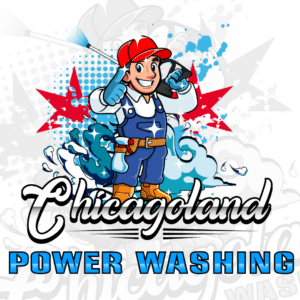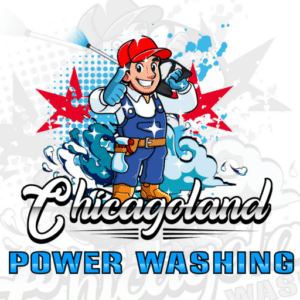The Importance of Roof Pressure Washing
Who would have thought that roof pressure washing was such an important part of property maintenance? It’s so easy to go about our day-to-day lives without once thinking about our roofs along the way. However, whether they’re on our minds or not, they are slowly gathering debris and becoming dirty. Eventually, they’ll need to be cleaned. In this blog, we’ll review the roof cleaning process, the reasons that it is so important, and your options for roof cleaning. We are Chicagoland Pressure Washing, a locally owned and operated business in Chicago, and we’re happy to be your guide during your roof cleaning journey!
How Roofs Become Dirty
It’s important to understand how roofs become dirty before we talk about the benefits of cleaning them. Your property’s roof works diligently to protect your home or business all twelve months of the year. During this time, it will encounter, and ultimately accumulate, many different forms of debris. Leaves and sticks will fall on the roof. Dirt will gather on its shingles or tiles. You may even discover moss, mold, and algae spreading across the roof like wildfire. All these forms of debris have something in common—they take a once-beautiful roof and leave it looking like it’s seen better days.
What happens if you allow your roof to continue accumulating debris throughout the years? Eventually, you may face consequences that go beyond reduced curb appeal. You may even have the displeasure of discovering that roof debris damages the roof. Over time, particles of debris will grind against your roof, gradually eroding it. In addition to this, organic debris stores water and causes moisture damage to your roof. The long story short is that it’s bad news all around, but don’t worry because you can prevent all this from happening with roof pressure washing.
What Is Roof Pressure Washing?
So, how exactly does roof pressure washing work? Technically speaking, when you clean a roof, you should actually use a similar technique called soft washing. Soft washing differs from pressure washing in that it involves much less water pressure. For example, concrete can be pressure washed with 3,500 PSI; roofs need to be soft washed with 150 to 500 PSI. This ensures that the delicate roof surface is treated with the care that it needs.
Since soft washing is less powerful than pressure washing, you may experience that debris does not rinse away as easily. Fortunately, with cleaning solutions, you’ll be able to break down this grime, making getting rid of it much less difficult. We recommend using sodium hypochlorite. This cleaning solution is not only safe for your property but also the environment.
How to Prepare For Roof Pressure Washing
To prepare for your roof cleaning project, there are several things you’ll need to do. First and foremost, you’ll have to purchase all the necessary equipment for the work. Additionally, you’ll need to find an opening in your schedule for the project. How many hours will you need for do-it-yourself roof cleaning? We recommend that you give yourself at least five hours. Cleaning your own roof can take a while, and you don’t want to run out of time. It’s better to have too much time than not enough.
You may also want to consider moving any of your belongings that are near the edges of your property. For example, patio furniture, potted plants, and decorations could suffer moisture damage as a result of overspray. Consider also protecting flower beds and other sensitive parts of your landscaping with tarps or drop cloths.
How to Soft Wash Your Roof
With all preparations out of the way, the process of soft washing your roof can begin. First, set your pressure washer to the correct water pressure level. This ensures that your roof is not damaged during the roof cleaning process. How much water pressure should you use? We have provided some basic guidelines below.
- Asphalt Shingles: 100–300 PSI
- Wood Shingles: 100–300 PSI
- Slate: 100–300 PSI
- Clay/Concrete Tiles: 300–500 PSI
- Metal Roofs: 300–500 PSI
Next, climb up your ladder and choose a starting point on your roof. By starting in a corner and washing the roof in a row-by-row manner, you’ll revitalize the surface’s appearance without losing track of what areas you’ve already cleaned. If you discover any stubborn debris, use sodium hypochlorite to weaken it. By simply applying a thin layer of this material to your roof and waiting a few minutes, all unwanted debris will be much easier to remove. Touch-up soft washing is all it will take to get rid of it for good.
General Safety Tips When Cleaning Roofs
Roof cleaning can be risky, but you can mitigate this risk with the right safety precautions. We’ve included some extra safety tips below. Read through them so you can have the safest roof cleaning experience possible!
- Avoid slipping. Keep a firm grasp of your ladder, wear non-slip shoes, and never attempt roof cleaning on a rainy or windy day.
- Steer clear of any nearby power lines. Not only will this protect you from being shocked, but it will also prevent damage to your property’s electrical systems.
- Do not stand on your roof. This can easily cause damage to the roof, and it can easily lead to you falling off the property, too.
Consider Professional Roof Pressure Washing
The process of pressure washing your roof is difficult. It requires time, energy, and the right equipment. If you are lacking any of these resources, doing your own roof cleaning might not be the right choice for you. Fortunately, we have the perfect alternative! By scheduling our professional roof cleaning, you will avoid this hard work entirely. That way, you can take some time to relax while our experts restore your roof to your complete satisfaction.
The best part is that we are prepared to do this work for a fair price. Contact us online, tell us about your roof, and receive a free cost estimate today. Then, choose a time and date for your appointment, and we will be there soon! It won’t be long before your roof looks its best again.



